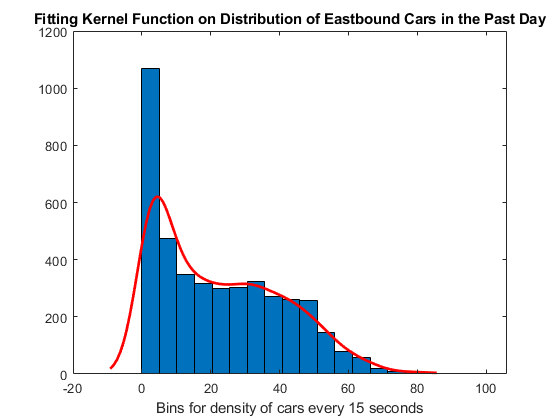Tracciare un istogramma con un adattamento della distribuzione
Questo esempio mostra come adattare una distribuzione ai dati in un canale ThingSpeak ™. Si genera simultaneamente un istogramma e un adattamento alla distribuzione dei dati sulla densità del traffico per un'autostrada nel Massachusetts.
Leggi i dati dal canale Car-Counter ThingSpeak
Il canale car-counter ThingSpeak utilizza un Raspberry Pi™ e una webcam per contare le auto su un'autostrada trafficata. Sul Raspberry Pi è in esecuzione un algoritmo di conteggio delle auto e la densità delle auto conteggiate ogni 15 secondi viene inviata a ThingSpeak. I campi 1 e 2 contengono rispettivamente i dati sul traffico in direzione est e in direzione ovest.
data = thingSpeakRead(38629,'NumDays',1,'Fields',[1,2],'outputFormat','table');
Filtra i tuoi dati
Prima di adattare la distribuzione, filtra i dati per rimuovere gli zeri.
data_without_zeros = data.DensityOfEastboundCars(data.DensityOfEastboundCars > 0);
Istogramma grafico e distribuzione adatta
Visualizza i dati sul traffico in direzione est come un istogramma e adatta una distribuzione come normal, poisson, gamma o kernel. Visualizzare i dati aiuta a comprendere la forma della distribuzione sottostante. Adattare una distribuzione di smoothing del kernel non parametrica.
number_of_bins = 20; histfit(data_without_zeros,number_of_bins,'kernel'); xlabel('Bins for density of cars every 15 seconds'); title('Fitting Kernel Function on Distribution of Eastbound Cars in the Past Day');

L'istogramma e l'adattamento mostrano che la distribuzione è asimmetrica verso destra.
Vedi anche
Funzioni
histfit(Statistics and Machine Learning Toolbox) |thingSpeakRead